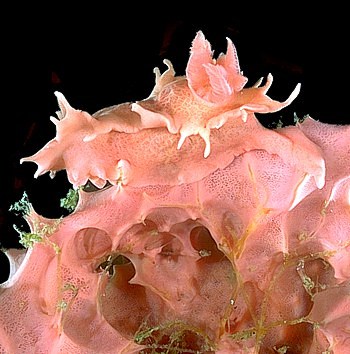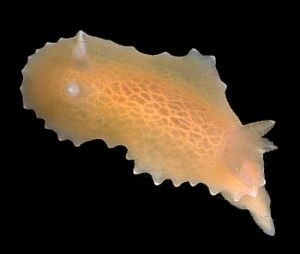
Verconia verconis
(Basedow & Hedley, 1905)
Order: NUDIBRANCHIA
Suborder: DORIDINA
Family: Chromodorididae
DISTRIBUTION
Southern Australia, (Victoria, Tasmania, South Australia, southwestern Western Australia).
PHOTO
UPPER RIGHT: 25mm long on food sponge Dendrilla rosea, LOWER LEFT: yellow juvenile, 9mm long, LOWER RIGHT: 25mm long adult. All Eyre Peninsula, South Australia, February 1985. PHOTOS: Bill Rudman.
Verconia verconis is one of the few chromodorids which are camouflaged by the shape and texture of their bodies, as well as by the colour of their skin. This species ranges from a deep pink in colour to yellow and orange, almost exactly matching the colour of the sponge they are feeding and living on. They also have a pale reticulate pattern over their body which matches the raised reticulate pattern formed by the fibrous skeletal structure of their food sponges. In juveniles we can see the early development of the triangular outgrowths around the mantle edge, which in adults extend into long elongate papillae. These papillae help camouflage the nudibranch amongst similar conical projections on the sponge colony. They also are defensive structures, each having a mantle gland situated at the tip. This can be seen in the juveniles, where the white mantle gland at the mantle edge, is clearly the focus point for later growth of the papillae.
Reference:
• Rudman, W.B. (1984) The Chromodorididae (Opisthobranchia: Mollusca) of the Indo-West Pacific: a review of the genera. Zoological Journal of the Linnean Society 81: 115-273.


Rudman, W.B., 1999 (August 29) Verconia verconis (Basedow & Hedley, 1905). [In] Sea Slug Forum. Australian Museum, Sydney. Available from http://www.seaslugforum.net/find/vercverc
Related messages
Verconia verconis? from Western Australia
March 23, 2006
From: Wendy Hutchison

Hi Bill
Is this nudibranch Verconia verconis as its shape and features tend to suggest? I understand that the species does adapt its colour to the sponges upon which it dines, but interestingly there did not appear to be any yellow sponges in the vicinity. I found it under the Busselton Jetty (WA) in about 10m during a day time dive some time ago.
Locality: Busselton Jetty, 10 metres, Wetern Australia, Indian Ocean, March 2003, Sand, rock under jetty. Length: 3-4 cm. Photographer: Wendy Hutchison.
Regards,
Wendy Hutchison
wenrose19@iinet.net.au
Hutchison, W.R., 2006 (Mar 23) Verconia verconis? from Western Australia. [Message in] Sea Slug Forum. Australian Museum, Sydney. Available from http://www.seaslugforum.net/find/16140Dear Wendy,
Yes this is Verconia verconis. Although its colour usually matches the sponge that it feeds on, I am not sure how much of the colour is genetically based and how much much is from pigment obtained from its sponge. I have often found it on sponges of a different colour so I tend to think genetics is quite important. It tends to feed on a number of species of darwinellid sponges which range in colour from pink to orange and yellow. With its shape and texture I suspect it looks much like a small darwinellid sponge colony itself, even when away from any sponge. Since darwinellids are avoided to a large extent by predators - because of the antifeedant chemicals later used by the nudibranchs - I guess looking like a sponge is as useful a defence as being able to hide on a sponge.
Best wishes,
Bill Rudman
Verconia verconis from Jervis Bay, eastern Australia
October 27, 2005
From: Sue Newson


Dear Bill,
I was reading your page on Verconia verconis and Akos's message [4187 ]regarding their distribution. I have also come across this beautiful nudibranch in Jervis Bay.
Locality: The Docks, Jervis Bay, NSW, Australia. Depth: 21 m. Length: 20 mm. 03 April 2005. Rocky reef. Photographer: Sue Newson
Sue Newson
suenewson@optusnet.com.au
Newson, S.T., 2005 (Oct 27) Verconia verconis from Jervis Bay, eastern Australia. [Message in] Sea Slug Forum. Australian Museum, Sydney. Available from http://www.seaslugforum.net/find/15108
Dear Sue,
Thanks for this interesting record. It is certainly unusual to find it this far up the east coast of Australia. It also looks out of place in this lush growth of bryozoans. I guessed its been washed off its food sponge, Darwinella, on which it is normally found, and mimics so well. The white tips to the 'tentacles' around the mantle edge are mantle glands which store defensive chemicals from the sponge.
Best wishes,
Bill Rudman
Verconia verconis from Sydney
April 15, 2001
From: Akos Lumnitzer

Hi Bill,
A friend of ours told us he found Verconia verconis at Kurnell, entrance to Botany Bay in Sydney last weekend. With only two rocks as reference points between which to find the beast, I went hunting for it.
Now there were at least 100 boulders to scan over, but I managed to find the nudibranch. It is definitely a first for me in Sydney and also for our friend Noel Conlon, who had only seen the species in South Australia before.
Interestingly this species of sponge is renowned for sustaining small communities of Chromodoris tasmaniensis, of which there were several tiny juveniles on the sponge itself. I also saw an egg ribbon, but to which species it belonged to is a mystery. Could it be possible for the V. verconis to store eggs and lay them upon a suitable food source????
Anyway, here it is and I am looking forward to taking my wife Donata out for a peek very shortly. Anyway, we did think it was an unusual sort of a creature for Sydney - that ought to make the other nudie nuts jealous.
Regards
Akos
dna72@softhome.net


Dear Akos,
This is indeed a very unusual find. As far as I know this species has never been found anywhere in New South Wales before. It has been considered a southern temperate species found from Bass Strait across to south-western Australia. The sponge in your photos seems to be a species of Darwinella which is its typical food. It is also the food of Chromodoris tasmaniensis.
The importance of this find is not just that it is a geographical range extension of about 500 kilometers further north than it has been found before, but it is an extension beyond the Green Cape [Victoria / New South Wales] boundary which seems to represent a real zoogeographic boundary in southeastern Australia. It is an extension north against the direction of the prevailing water movements. I presume this is a natural range extension although I guess it is possible someone has transplanted it, or it has spread with shipping. I guess all we can do is see what happens and ask anyone diving in New South Wales to keep a look out for it.
If you get a chance, I would be interested in a photo of the juvenile C. tasmaniensis and the egg mass you mention. The eggs of C. tasmaniensis are quite large, so it might be possible to identify the egg ribbon. This is indeed an interestng find
Best wishes,
Bill Rudman
Egg-laying Verconia verconis
April 1, 2001
From: John Chuk

Dear Bill,
Here is a photo of Verconia verconis egg-laying. It was taken on a night dive at Rapid Bay Jetty in South Australia on 19 February 2001. The specimen was 4.5cm in length and was found on the rubble bottom beneath the jetty at a depth of 9.5m.
Best Wishes,
John
jchuk@giant.net.au
Chuk, J., 2001 (Apr 1) Egg-laying Verconia verconis. [Message in] Sea Slug Forum. Australian Museum, Sydney. Available from http://www.seaslugforum.net/find/4070Thanks John,
In this head-on view you can see the egg-ribbon being extruded from the genital opening on the animal's right side before being pressed to the substrate by the sole of the foot.
Best wishes,
Bill Rudman
Pink nudibranch from Victoria, Australia
March 27, 2001
From: Terry Swanson

I would very much appreciate some advice on the following nudibranch I found under Portsea Pier [Victoria, Australia]. The specimen was about 50mm(2inches)long, light-medium pink, white globules on the end of a number of appendages on its body and from closer inspection of the slide its body has a texture similar to the pink prickly sponge we have over here.
Terry Swanson
terry.swanson@dtf.vic.gov.au
Swanson, T., 2001 (Mar 27) Pink nudibranch from Victoria, Australia. [Message in] Sea Slug Forum. Australian Museum, Sydney. Available from http://www.seaslugforum.net/find/3987Dear Terry,
Your animal is Verconia verconis, a species found only in southern Australia, from Victoria to Western Australia. It is a chromodorid nudibranch with unique papillae along the mantle edge which help it to mimic the shape of the sponge it is usually found on. As you have noticed, the papillae have white glandular structures at their tips which store defensive chemicals which they have obtained from their sponge food.
Have a look at the top of this page, and at the other messages below yours on this page for more information. Also have a look at the page on Nudibranch Defence.
Best wishes,
Bill Rudman
Variation in Verconia verconis
February 8, 2000
From: Stuart Hutchison


Dear Bill,
Here are some more shots of Verconia verconis from South Australia to add to you collection.
The upper one is from Edithburgh [East side Yorke Peninsula], Jan 99, 3m eggmass, colour variation. The lower one is from Port Hughes [West side Yorke Peninsula] in Mid 98 and clearly has broader mantle appendages. This seems to be the usual difference between V. verconis on the eastern side of Yorke Peninsula and those on the western side.
Stuart Hutchison
hutchco@tpg.com.au
Hutchison, S., 2000 (Feb 8) Variation in Verconia verconis. [Message in] Sea Slug Forum. Australian Museum, Sydney. Available from http://www.seaslugforum.net/find/1841Dear Stuart,
I had a look through my records of Verconia verconis to see how they fitted to your idea of broader mantle appendages on the west of Yorke Peninsula and narrower on the east and found photos of both sorts occurring on Eyre Peninsula (to the west of Yorke Penin.) and both in Port Philip Bay, Victoria, (to the east of Yorke Penin).
It's possible the difference reflects the shape of the sponge they are on or perhaps whether they are well fed or not. Keep an eye on it, you may find an interesting explanation.
Best wishes,
Bill Rudman.
Juvenile Verconia? from South Australia
January 30, 2000
From: Stuart Hutchison

Dear Bill,
Here is another one from Edithburgh, Yorke Peninsula, South Australia, - Edithburgh Christmas last year - I think this 5mm long specimen may be a juvenile Verconis (common at Edithburgh). Only sighting in five years. Regards,
Stuart Hutchison
hutchco@tpg.com.au
Hutchison, S., 2000 (Jan 30) Juvenile Verconia? from South Australia. [Message in] Sea Slug Forum. Australian Museum, Sydney. Available from http://www.seaslugforum.net/find/1759Dear Stuart,
I think you are right in thinking this is a juvenile Verconia verconis. It starts life looking like a 'normal' chromodorid, and as it grows, each mantle gland at the edge of the mantle, begins to be carried out on the tip of a papilla, which gradually elongates until it reaches its remarkable adult shape.
Bill Rudman.
Orange Verconia verconis
January 28, 2000
From: Stuart Hutchison

Dear Bill,
Here is an orange Verconia verconis I saw at Edithburgh, Yorke Peninsula, South Australia, a couple of weeks ago. Thought you might be interested.
Regards,
Stuart Hutchison
hutchco@tpg.com.au
Hutchison, S., 2000 (Jan 28) Orange Verconia verconis. [Message in] Sea Slug Forum. Australian Museum, Sydney. Available from http://www.seaslugforum.net/find/1756Thanks Stuart,
Your photo fills a gap in the colour variation I have on display. The white glands at the tips of the mantle papillae [see inset] are very obvious in your photo.
Best wishes,
Bill Rudman.
Verconia verconis from southern Australia
August 30, 1999
From: Bill Rudman
I have added a page on the remarkably well-camouflaged Verconia verconis to complement Scott Johnson's message on a cryptic dorid from the Marshall Islands.
Bill Rudman.
